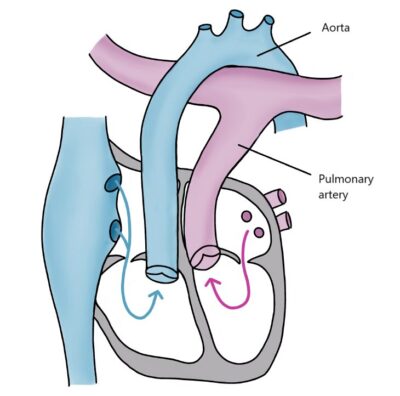Transposition of the Great Arteries, TGA
In this heart defect, the origins of the aorta and the pulmonary artery are transposed (TGA, Transposition of the Great Arteries). The aorta abnormally arises from the right ventricle, and the pulmonary artery from the left. Oxygen-rich blood from the lungs returns to the pulmonary artery via the left ventricle and back to the lungs, while oxygen-poor venous blood from the body flows through the aorta from the right ventricle back to the body. Due to the lack of oxygen, the child appears cyanotic and requires urgent treatment.
Administering supplemental oxygen does not affect the blood oxygen saturation because the oxygen-rich blood from the lungs does not reach the body. While awaiting corrective surgery, the patient is given medication intravenously to prevent the closure of the ductus arteriosus. Often, an atrial septostomy is needed to enlarge the atrial septal defect during cardiac catheterization. This ensures the mixing of arterial and venous blood and the exchange of respiratory gases.
The current corrective surgery, known as the arterial switch operation, has been in use in Finland since the 1990s. It is usually performed at about one week of age. During the surgery, the great arteries are severed at the base and switched. At the same time, the coronary arteries are relocated to originate from the base of the aorta that arises from the left ventricle. After the correction, there may be stenosis in the pulmonary artery and coronary arteries. Patients require lifelong cardiac monitoring.
Between 1965 and 1985, the surgical method used for the correction of transposition of the great arteries was atrial tunneling according to Senning or Mustard. The severe late complications associated with these surgeries gradually led to a shift from physiological correction to anatomical correction, the arterial switch operation. Most patients treated with atrial tunneling develop significant morbidity and mortality-enhancing complications. Patients who undergo the arterial switch operation can expect different and fewer problems compared to those treated with atrial tunneling.
